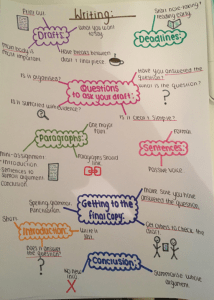The second blog post following on from our Pandemic Pedagogy initiative is by Lucinda Matthews-Jones, a lecturer at Liverpool John Moores University. She teaches nineteenth-century gender and urban history modules. Her dynamic and innovative teaching approaches were recognised in 2018 when she awarded a Vice-Chancellor’s Individual Teaching Award. Beyond the classroom, she researches ideas of home and urban domesticities in the British Settlement Movement, 1880-1920. Lucinda tweets @luciejones83.
I am a paper-based lecturer and teacher. Before COVID-19, you would have found me moving around my university building with large rolls of paper and a tote bag filled with coloured pens, glue sticks, post notes, and scissors. For me, asking students to work on paper in groups or as individuals enabled them to break down and cement their ideas through a visual format. It helped me to see what they had picked up and to expand these points in classroom discussions.
But how could I replicate this in the digital classroom? There has been a tendency to think that this needs to be done through digital tools. But if the non-digital class can be based on mixed media then why not the digital, too? Why must the digital classroom be paperless? It felt like digital fatigue had hit both me and the students in the second half of the semester in Autumn 2020. Discussions with personal tutees and other students had made me increasingly aware that recorded lectures were taking a lot of time and energy both to produce and consume. As History UK’s Pandemic Pedagogy Handbook observed ‘screen-time and remote interaction have a cumulative effect; the result is mentally and physically draining’.
My first-year students had a ‘how to respond to your feedback’ seminar coming up for their academic skills module and I wanted to think more creatively about how to get them to engage with the department’s writing guide. I decided that breaking it down and asking students to create a zine relating to the section that they had been assigned would help them to process the complex information written down in the guide and get them to think about how to communicate this in a creative manner. Students were sent class instructions through our VLE (see below).
Here is a picture of one zine and the page from LJMU’s History Guide it refers to.
Students reported that the exercise encouraged them to read the material differently by emphasising the need to break it down and to think about how to display the guide’s information. They enjoyed the idea that the exercise was for a wider audience and not just them reading through the guide on their own. At the end of the session, contributions were sent to me and put into a PDF.
Handwriting and hand drawing can improve people’s ability to remember. Hetty Roessingh, for instance, has noted that handwriting notes and sketching has enhanced her students ‘understanding and remembering’ by encouraging them to make ‘personal connection’ through ‘creative thought’. Roessingh continues that ‘hand-written notes matter and endure over time.’ Asking students to do paper-based creative exercise also changes the embodied experiences of digital learning. It encourages the eyes to look down and focus on the task, minimising screen time during a seminar.
The picture above shows a mind map illustrating one approach taken by students.
This session was intended to be light-hearted and a bit different from previous weeks. What I found was that I really enjoyed it. The conversations were dynamic and interesting as I moved around the breakout rooms. I felt more like me as a lecturer, having neither the know-how nor confidence around some digital technologies that others have used to transition their teaching online. Paper based activities will now be the focus of my teaching in semester 2.
What paper-based activities have you been using in your teaching? I would love to hear!
Class instructions
To help you prepare for the next assessment we will be digging into the LJMU Writing Guide. Together we will create a zine of top tips from this based on your feedback and what surprises you from the guide and feel your peers would benefit from.
Before class:
- Please make sure you have downloaded: LJMU_Writing_History_v1.pdf
- Have some paper and any coloured pens to hand. You can also bring newspaper, magazines, glue, and scissors if you want to do something more multimedia. But you do not have too. You can do this exercise on a class.
In class:
- You will be spilt into groups and given a section
- Be able to take an image of your hand out and email to Lucie for her to collate.
- Be prepared to summarise and explain your zine page.
Want to know more about Zines? Read here: How to Make a Zine: Guide to Making Your Own Zine During Quarantine – Thrillist (Links to an external site.).
If you would like to contribute a short blog post or podcast/video that addresses how the pandemic has changed or affected history teaching and learning in Higher Education then please email Dr Sarah Holland (sarah.holland@nottingham.ac.uk), History UK’s Education Officer.


You must be logged in to post a comment.